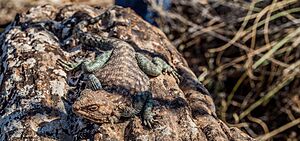Agama bibronii facts for kids
Quick facts for kids Agama bibronii |
|
|---|---|
 |
|
| Conservation status | |
| Scientific classification | |
 |
|
| Synonyms | |
|
Agama bibronii, also called Bibron's agama or the North African rock agama, is a type of lizard. It belongs to the family called Agamidae. You can find these lizards in north-western Africa.
Contents
About Bibron's Agama
Bibron's agama is a medium-sized lizard. It can grow up to 25–30 centimeters (about 10-12 inches) long. About 15 cm (6 inches) of this length is its tail, which is shaped like a cylinder. Its back scales are quite large and all the same size. It has some small spikes on its neck and the sides of its head. The skin on its throat looks a bit wrinkled. Male lizards are usually bigger than females.
The lizard's back is a grayish-green color with brown spots. Its head is blue, and it has orange rings around its eyes. When it's time to breed, the male's head and body turn a coppery-orange. The rest of its body becomes purplish-blue, and its tail gets lighter rings. Female lizards are mostly bluish-gray. Their backs are orangey-yellow with red stripes. The colors can change depending on the lizard's age or how much sun it gets. Young lizards have small bumps where their spikes will grow when they get older.
Where They Live
Bibron's agama lizards live in north-western Africa. Most of them are found in Morocco. However, they also live south into Western Sahara and east into Algeria, reaching as far as Batna Province. They might also be found in the Zemmour Massif in northern Mauritania.
Their Home and Habits
Bibron's agamas like to live in rocky areas. They are active during the day, which means they are diurnal. Their main food is arthropods, like insects and spiders. But they also eat small lizards and even plants. In Morocco, these lizards are thought to eat flowers mainly to get water. They can also be found in areas with Mediterranean plants, dry grasslands (steppe), and near farms if there are good hiding spots.
Female agamas usually lay one or two groups of eggs each year. Each group, called a clutch, has between 6 and 23 eggs. On average, they lay about 14 eggs. The breeding season is from late April to early September. Females start laying eggs in their first year. Most breeding females are 1 to 2 years old.
These lizards are very good at climbing trees and rocks. They can handle hot temperatures and lots of sun. However, on the hottest days, they might hide in the shade. If they feel in danger, they can quickly run to hide between rocks or under a bush. In places with lots of food and good hiding spots, many of these lizards can live close together.
Snakes and birds of prey, like eagles, are their main predators. If an agama can't run to a hiding spot, it might pretend to be dead. At night, they sleep in a burrow. They dig these burrows under large stones, in banks, or under embankments. The main burrow is usually less than one meter long and can have several side tunnels.
When not looking for food, male agamas often sit on a rock or a pile of rocks. From there, they watch over their territory. Each male's territory can be from 100 to 500 square meters in size.
When two male agamas meet during breeding season, they try to look as big as possible. They puff up their throats and push their front bodies up with their front legs. This is to try and scare the other male. If one male doesn't run away, they might start a fight. They circle each other and use their tails like whips until one gives up and runs off.
When a male approaches a female ready to mate, he moves in circles. The female shows she is ready by arching her back and raising her body and tail. The male then bites the back of her neck and they mate. The eggs develop a lot inside the female before they are laid in moist soil. It seems the parents don't take care of the eggs after they are laid. The eggs hatch after about 60 days.
How They Are Named
The scientific name Agama bibronii was first officially described in 1851. However, for a while, people thought this name was already used for another lizard. So, the species was often called by another name, A. impalearis. But in 1970, a special group that names animals decided that Agama bibronii was the correct name. Even so, some scientists still use A. impalearis.
The name bibronii honors a French scientist named Gabriel Bibron. He was the first to describe this lizard but didn't give it a specific name. His notes were later used in a book by André Marie Constant Duméril and his son, Auguste Duméril, in 1851. That's when Duméril officially named the species.
Scientists have also studied the genes of Agama bibronii. They found that there are two main groups of these lizards. One group lives north and west of the Atlas Mountains, and the other lives south and east. There are some small differences between these groups. This suggests that they might actually be two separate species.
Keeping Them Safe
Bibron's agama is found over a large area. There are no known big threats to this species. These lizards are sometimes sold as pets in Europe. However, collecting them for the pet trade is not thought to be a risk to the overall number of lizards in the wild.
Images for kids




